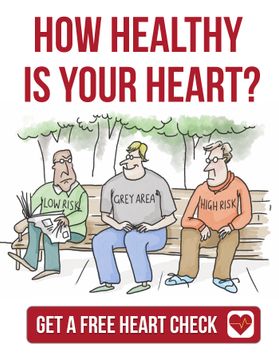JOIN OUR HEALTHY HEART MEMBERSHIP HERE: https://healthyheartnetwork.com/page/starter
Welcome to Warrick's Podcast Channel. Warrick is a practicing cardiologist and author with a passion for improving care by helping patients understand their heart health through education. Warrick believes educated patients get the best health care. Discover and understand the latest approaches and technology in heart care and how this might apply to you or someone you love.
Hi, my name is Doctor Warrick Bishop, and welcome to my podcasting videocast channel, and welcome to the Healthy Heart Network. Today, I want to talk a little bit about what happens if the valves of the heart stop working. Well, before I cover that in too much detail, what I'd like to do is quickly remind us of how the circulation works. Now remember, I said, if we could imagine the circulation as a single tube where blood circulates around that tube, almost imagine the inner tube of a tyre, and at twelve o'clock, we've got the lungs, which is where gas exchanges, oxygen comes in and carbon dioxide goes out. And at six o'clock, we have the capillaries, which is where carbon dioxide is created from the metabolism of the tissues that the capillaries are in, and where oxygen is absorbed into those tissues so the metabolism can occur. And what occurs in the rest of the circulation is blood out and blood returning. Remember, we had drawn a diagram which sort of showed the lungs at twelve o'clock, the capillaries at six o'clock, blood going out and blood going back in.
Now, either side of the lungs, there is the right side of the heart and the left side of the heart. As blood comes back from the body, through the veins, the veins coalesce and come together into a major vein above and below the right atrium of the heart. These major veins that come together are called the superior and the inferior venae cavae. And they drain directly into the right atrium, which is the receiving chamber of the right side of the heart. The right atrium gives the blood a little squeeze, the blood goes into the right ventricle, which is the main pumping chamber on the right side of the heart, and the right ventricle then pumps blood through the pulmonary valve into the pulmonary artery to get blood into the lungs. This blood is the venous blood, so it's a dark purple colour. While it's in the lungs, though, the blood then exchanges carbon dioxide and oxygen so that as it comes back out of the lungs, it's now the bright red arterial blood, which is carrying oxygen and released or got rid of the waste carbon dioxide. This is the bright red blood that we see on the arterial side of the circulation.
Reminding you that the arterial blood now comes from the lungs, through the pulmonary veins, drains into the left atrium. The left atrium receives the blood from the lungs, gives the blood a little squirt. The blood from the left atrium goes through the mitral valve, which is the one-way valve into the left ventricle. The left ventricle receives that blood, and then the blood goes out the one-way valve into the aorta, and then oxygenated blood - that bright red blood - then begins its journey around the circulation. So, if you reflect on that circular flow and the heart really having two major sides: the right side and the left side, and each of those sides having a pre-pumping chamber and a main pumping chamber, then at each of these junction points where there's contraction occurring, there is a one-way valve. They're the valves of the heart.
In order, they're the tricuspid valve, pulmonary valve, mitral valve, and aortic valve. But it turns out that, from a clinical perspective, or from this perspective that's most likely to affect you, we tend to see the valves affected in the reverse of that order. So, the aortic valve, then the mitral valve, then the tricuspid valve, then the pulmonary valve, tend to be affected in that order in the clinical situations that we tend to deal with in our cardiological practice. Now, when a valve fails, it can fail in two ways. If we think about it, it's very simple to understand: a valve can become narrowed or tight, and if it does that, it doesn't allow enough blood through. It becomes a blockage in the system. The other way a valve can fail is if it doesn't do its job properly. If it leaks. So, if our one-way valve lets blood through, but then when it closes, it doesn't close properly, or for some reason doesn't do its job properly, then blood leaks back from whence it came. The first type of situation, a narrowed valve; one that's not opening properly, we call that a 'stenosed valve'; a narrowed valve. A valve that doesn't close and allows leakage of blood back, we call that an 'incompetent valve.' It's not doing its job. It is incompetent in what it's meant to be doing. We also call that a 'regurgitant valve'; it's regurgitating blood. So, two ways a valve can fail.
Let me talk about the aortic valve, first of all. What I will say, before going into too much detail about these valves is that, in general terms, if we see a valve fail suddenly, it's normally a regurgitant failure. So, if we see heart failure in the acute setting, in the sudden onset setting, and it's related to a valve, it's normally a valve that is leaking. It's uncommon for the valve to become stenosed suddenly. This is a process that normally occurs over years, generally decades, in fact. So, let's talk about the aortic valve, and let's talk about the aortic valve narrowing first. Let's think about the flow of the blood. Blood has come through the circulation, through the veins, the right side of the heart, through the lungs, through the left side of the heart, gets pumped by the left atrium into the left ventricle. Everything's working well so far. Now the left ventricle goes to squeeze blood out to the body, the left ventricle goes to squeeze blood out into the aorta, and lo and behold, the valve is narrowed.
Now, the narrowing can be to different degrees, and we like to measure exactly what sort of degree of narrowing is occurring, because we know once the narrowing gets to a certain level, then that valve is critical, and that valve needs to be replaced. So there are two things that we try to understand as we're doing our ultrasound assessment of a valve that's narrowed. The first is that we try and measure the area of that valve. We try and understand exactly what the cross-sectional area is of the narrowed valve so that we can compare that to what would otherwise be a normal area. Once the valve area of the aortic valve is getting less than one centimetre squared, we start to get pretty concerned. We're able to do those calculations and measurements from some of the clever techniques we use with echocardiography, where we can measure the size of the aorta, and we can measure flow velocity through the narrowed area, and we can compare that with the other side of the heart; so that we can compare flow on the left side with flow on the right side of the heart. And by comparing those two flows and knowing they're going to be equal, we can start to make a calculation of the area that's functional of a stenosed or narrowed aortic valve.
The other thing that we measure is the pressure gradient across the valve. This is something that's really important to understand because we talk about these pressure gradients all the time. A pressure gradient simply means the difference in pressure between one side of the valve - the left ventricle - and the aorta - the other side of the valve. To make that easy to understand: if there was a zero gradient, then the pressure in the left ventricle would be exactly the same as the pressure in the aorta. Now, how do we make that all add up? Well, the pressure in the aorta should be the same as the pressure in the artery in the arm. So, if we were to measure someone's blood pressure, and that blood pressure was 120 millimetres of mercury, then we would know that the pressuring the aorta was 120 millimetres of mercury at systole, which is when the heart's contracting, and if there was a zero gradient over the valve, then the pressure in the left ventricle would be 120.
So, no pressure gradient over the valve. Now, if we then think about increasing the gradient over that valve, then what we're talking about is the narrowed valve leading to a failure of all the pressure in the left ventricle going into the aorta. So now, let's say that the pressure in the aorta remains at 120, but now, the pressure in the left ventricle is, let's say, 200. So, let's think about the left ventricle. Let's think about the aorta, and let's think about the valve and the blood pressure that we measure in the arm.
On this occasion, we don't have a zero gradient. On this occasion, the pressure in the aorta is 120. This is the pressure that the body wants to continue to maintain for optimal function. The pressure in the aorta is 120, therefore the pressure in the arm is pretty well equivalent. And that's because of transmission of that pressure through the fluid. So, pressure in the arm, 120, pressure in the aorta, 120. But because the valve is thick, the ventricle has to pump it 200 to achieve that pressure of 120 in the aorta. With the ventricular pressure being 200 and the aortic pressure being 120, then the pressure drop due to the valve is 80 millimetres of mercury. That means that the pressure gradient over the valve is 80, and in our clinical situation, we believe that is severe.
So, when we're trying to assess the narrowing of the valve, we calculate the area, and we do that using our echocardiogram and clever techniques, looking at flow, comparing the left and the right heart. And we also use our echocardiogram to establish the gradient over the valve, the pressure differential that occurs across that valve, because those two factors, the area, and the gradient, help us decide when a valve needs to be replaced. Well, what are the consequences of having a narrowed valve in the aortic position? Well, if you think it through, the left ventricle has to do more work.
So, over time, the left ventricle thickens up so that it's strong enough to pump out through that valve. And so one of the consequences we see of aortic valve stenosis is a thickened muscle of the main pumping chamber of the heart, or a thickened left ventricle. That same pressure, of course, is exerted back on the mitral valve, and sometimes, can impact the mitral valve as well, because it puts pressure on there. And you can imagine that if the left ventricle is squeezing really hard to try and get blood to go out the forward way, it could also be squirting blood backwards and putting pressure on the mitral valve, so it becomes regurgitant. Although, aortic valve is stenotic.
A bit to take on board there. One of the things that are really important to understand with the timing of valve surgery, is that we want to keep a close eye on how patients progress in terms of their symptoms, and the severity of their valve. And this is the same for all valves. And there's really a simple way to break down the way we consider that, and we consider that in terms of severity, and timing. And what we know is that, with time, most valves will gradually worsen. So, the stenotic aortic valve that we're talking about will gradually worsen, and we will want to monitor that closely, but it's really important we understand that that monitoring so that we can pick the best time to change or repair that valve. We can do it too early.
Now, if the gradient over the valve was low. If the area of the valve was only slightly reduced compared to a native normal valve, and we looked to replace that valve, then that would be too early, particularly if the patient didn't have any symptoms at all. Too early means that we're putting in a new valve when the existing valve is not that bad. Well, too early runs the risk that we may well run the complications of the surgery without making the patient feeling any better. So we don't want to be doing people too early. Sometimes, we can leave things too long. And if we leave the heart too long, you can imagine if we left a left ventricle under load for too long. It might eventually fail of its own. It might become thickened and get to a stage where eventually it just doesn't pump well enough. Or the stenosis becomes so tight that the patient actually runs a risk of sudden cardiac death.
If that's the case, if the muscle of the heart doesn't recover after surgery; if the patient has unacceptable risk of consequences or symptoms from the tight valve, then that's too late in terms of our timing. What we really aim for is a bit of a Goldilocks spot where it's just right. Where the patient is starting to get symptoms where the valve is severe enough that we know if we replace it, we will give them the better valve hemodynamically, and where we know that the risk of surgery is now less than leaving the valve as it is. So it's really important we get that timing right.
I'm going to talk lastly about a leaking aortic valve. In fact, what I'll do is I might stop there because we've covered quite a lot. I might talk about a leaking aortic valve, the mitral valve next time, and the right heart valves. We've covered quite a lot. The detail around understanding what goes on with valves as they fail and how that impacts the heart is really important, and it's really common. I hope some of the information I've shared with you today makes sense. If it doesn't, let us know. If you have any thoughts about future topics, please let us know. I'm going to wish you the very best for now, and of course, until next time, good health and goodbye.
You've been listening to another podcast from Dr. Warrick. Visit his website at drwarrickbishop.com for the latest news on heart disease. If you love this podcast, feel free to leave us a review.
Check out my book at http://drwarrickbishop.com/books/









